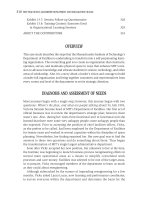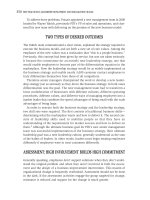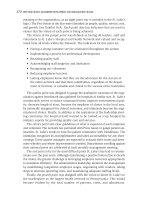Tài liệu Best Practives in Leadership Development & Organization Change 38 ppt
Bạn đang xem bản rút gọn của tài liệu. Xem và tải ngay bản đầy đủ của tài liệu tại đây (143.83 KB, 10 trang )
340
BEST PRACTICES IN LEADERSHIP DEVELOPMENT AND ORGANIZATION CHANGE
• Execute. Achieve results significantly better and faster than our competitors
by employing innovative, proven, and rigorous management practices.
Personally meets commitments and keeps promises.
• And always, Ethics and character. Conducts business ethically always
and everywhere. Treats all people and all cultures with respect and
dignity. Keeps one’s personal ambitions and emotional reactions from
interfering.
Motorola’s CEO also articulated a five-point plan for achieving business
results in which improved leadership effectiveness topped the list.
Motorola’s Performance Management Process
Motorola’s performance management process is an ongoing cycle of setting per-
sonal goals that align with the business’s scorecard objectives, then observing
and discussing performance issues, development plans, job match, and career
plans throughout the year. The process culminates with year-end assessment of
leadership behavior and business results, calibrated across leadership ranks,
which in turn informs differential investment decisions (for example, incentive
plan payout, executive education opportunities, assignment to special CEO
project teams) based on relative contribution to the company’s performance.
Outcomes of assessment and calibration of relative performance feed into goal
setting for the next year, and the cycle repeats.
Planning Dialogue. The planning dialogue occurs at the start of the year, and
its purpose is to create mutual understanding of performance expectations
between employees and their managers. The discussion focuses on defining
results goals aligned with the business or function scorecard, and leadership
goals focused on behavior most critical for attaining expected results. Once goals
are defined, the discussion turns to establishing professional development and
career plans that will enable employees to achieve their immediate performance
and future career goals.
Checkpoint Dialogues. The purpose of checkpoint dialogues held in the sec-
ond and third quarters is to review progress to goals. Key to these discussions
is performance feedback from key work partners and matrix managers. Check-
point dialogues provide the opportunity for employees and their managers to
assess progress to goals and development plans, discuss goal modifications
to support changing circumstances, create action plans to address barriers to
success, and check for understanding and agreement.
Assessment of Results and Behaviors. At year-end, two performance assess-
ments are made. First, leadership effectiveness is evaluated via a web-based
cart_14399_ch14.qxd 10/19/04 1:16 PM Page 340
MOTOROLA
341
multirater assessment based on the “4e’s ϩ Always 1” leadership standards and
administered to executives, their managers, and their subordinates. Rater input
is combined statistically to produce an overall leadership behavior score. Second,
performance to results goals is evaluated and jointly agreed upon by the employee
and manager, using metrics established during the planning dialogue.
Calibration. Following year-end performance assessment, managers participate
in a calibration process—supported by the web-based information system—to
share rationale for performance evaluations and come to agreement on the
relative performance of the employees reporting to them.
Managers view their direct reports’ results and leadership behavior scores
plotted graphically (with results plotted on the horizontal axis and behav-
iors plotted on the vertical axis). Discussion follows of each person’s individual
and relative contribution based on results, leadership behaviors, and other legit-
imate business factors (such as job complexity, stretch in goals, technical skills,
special expertise, breadth of experience). The end result is a collectively deter-
mined relative ranking of employees into most effective, solidly effective, and
least effective groupings.
Summary Dialogue. Following calibration, managers and employees complete
the summary dialogue to review individual performance through year-end, dis-
cuss calibration outcomes, refine development plans, and begin planning for the
coming year. Aiding the discussion is a comprehensive feedback report derived
from the multirater assessment that not only displays ratings and comments but
also suggests development actions from For Your Improvement (Lombardo &
Eichinger, 2000) for areas requiring improvement. These suggestions are very
useful in guiding development of performance goals, creating development
plans, and discussing career plans.
Link to Rewards
Executive rewards play a key role in driving Motorola’s change to a performance-
based culture. Differential investment—rewarding executives commensurate with
their overall contribution to the success of the company as determined during
calibration—sends a clear message to employees that results and leadership
behavior are what count. Leaders considered most effective have produced break-
away results and have demonstrated exemplary leadership behavior. They are
rewarded with challenging job assignments, promotional and developmental
opportunities, and significant monetary awards. Somewhat less, yet still consid-
erable, investment is made in solidly effective leaders—those who “deliver the
goods” consistently and demonstrate leadership behavior. They are compensated
competitively and provided opportunities for continued learning and develop-
ment. Modest investment is made in least effective talent to find a way to
cart_14399_ch14.qxd 10/19/04 1:16 PM Page 341
342
BEST PRACTICES IN LEADERSHIP DEVELOPMENT AND ORGANIZATION CHANGE
improve performance through job reassignment, performance improvement
plans, referral to the company’s employee assistance program, or as a last resort,
separation with dignity.
SO WHAT?
By the end of its third full year of implementation, the leadership supply
process was producing observable change. In those years, new leadership tal-
ents were placed in all but three of the roles reporting to the CEO; one-third of
the new senior staff had been brought in from outside the company; and a
balance of technical and general management skills among the staff had been
achieved. By year-end 2003, Motorola had placed over seventy new leaders in
its top one hundred jobs, including a new CEO, COO, CFO, CTO, and six sector
presidents.
Probably the most telling story, however, is Motorola’s improved business
performance in a very tough economic environment. Based on the company’s
fourth quarter, 2003 financial report:
• Earnings per share were $0.38 (excluding special charges), up from
Ϫ$1.78 at year-end 2001
• The company had reported profitability for seven consecutive quarters
• Operating margin was 4.3 percent, up from Ϫ6.0 percent for 2001
• The company had reported twelve consecutive quarters of positive
cash flow
• Net debt was $100 million, down from $7 billion in 2000
• Net debt to net debt ϩ equity ratio was 0.3 percent, the lowest in
twenty years
LESSONS LEARNED AND “DO DIFFERENTLIES”
Reflection over the past three years of development and implementation yields
insights into what worked well, and what didn’t work so well. Both provide
perspective for others contemplating the leadership supply issue.
What Worked Well?
• Strong sponsorship by a key executive during the redesign phase led to
CEO ownership of the process.
• Business leaders were actively involved in the redesign process. Human
resources did not own the redesign, but instead worked with and
through business leaders who led the redesign teams.
cart_14399_ch14.qxd 10/19/04 1:16 PM Page 342
MOTOROLA
343
• Hiring an outside consultant to complete the benchmarking study gave
Motorola access to information about leadership programs in other
companies without expending scarce internal resources to collect and
consolidate this information.
• Web-enabling the process was key to achieving consistency of applica-
tion throughout the company. It also minimized ongoing administration
because the web-based tools compile and report without the need for
human intervention.
• The Office of Leadership, the new central organization created to
manage the leadership supply process, was purposefully kept very
small. With web-based tools and implementation carried out by
resources within the individual business units, the Office of Leadership
was staffed by fewer than ten people, minimizing cost to the organiza-
tion and avoiding the trap of creating a centralized bureaucracy.
• The CEO mandated that executives comply with the new leadership
supply process, particularly with respect to assigning rewards commen-
surate with personal and organizational performance. Although unpopu-
lar, the mandate served to jump-start the process, short-circuit resistance
to change, and quickly gain acceptance as the value of the process
became evident.
• Establishing semi-annual talent management reviews between sector
president and CEO created a rhythmic cadence to the process, reinforced
the expectation that development and deployment of leadership talent
was to be managed as aggressively as P&Ls, and ensured continued
ownership of executive leadership talent and the leadership supply
process by the CEO.
“Do Differentlies”
• The broader human resources organization was not kept up-to-date
during the redesign phase. As a consequence, implementation was
hampered by the need to assuage feelings of ill will from having
been excluded from “the action,” convince HR associates of the need
for change, and enlist them as change agents as the process was
rolled out.
• An external management consulting firm was brought in to build, inte-
grate, and pilot HR processes, tools, and procedures. Given the success
achieved through partnership with an external consultant in the
redesign phase, this approach seemed reasonable. Unfortunately, the
consulting team was not up to the challenge and the project lost
momentum until an internal team was assembled to take over and com-
plete it. In retrospect, the build and implementation phases should have
cart_14399_ch14.qxd 10/19/04 1:16 PM Page 343
been led by an internal team from the outset, with consultants brought
in as needed to work on discrete, specific components requiring exper-
tise not available within Motorola.
• The web-based infrastructure supporting the process was developed
internally, saddling Motorola with the cost of ongoing maintenance and
system improvements. Had the sophisticated HR systems that exist
today been available then, the better option would have been to
customize commercially available software to meet Motorola’s specific
needs.
REFERENCES
Lombardo, M. M., & Eichinger, R. W. (Eds.). (2000). For your improvement (3rd ed.).
Minneapolis, Minnesota: Lominger Limited, Inc.
McKinsey & Company. (1998). “The war for talent.” The McKinsey Quarterly, No. 3.
McKinsey & Company. (September 2001). “Performance ethic: out-executing the
competition.” Organization and Leadership Practice. Charlotte, South Carolina:
McKinsey & Company.
ABOUT THE CONTRIBUTORS
Kelly Brookhouse, in her role as director, leadership, learning, and performance
at Motorola from 1999 to 2003, played a central role in conceptualizing and
directing Motorola’s leadership supply core process redesign effort, including
design and development of the procedures, tools, support materials, and inte-
grated information systems required to translate the leadership supply process
from vision to reality. Prior to joining Motorola in 1997, Kelly was senior vice
president of Aon Consulting’s start-up preemployment testing outsourcing group
established in 1994. Her career began as a human resource consultant with
HRStrategies, during which time she designed, validated, and implemented pre-
employment testing, developmental assessment, and performance management
programs for numerous Fortune 100 companies, including Motorola. Kelly
obtained her doctorate in industrial and organizational psychology in 1987 and
is a member of the American Psychological Society and the Society for Indus-
trial and Organizational Psychology. Kelly currently is director, leadership devel-
opment at Capital One Financial Services, Inc.
Jamie M. Lane, vice president, leadership, learning, and performance, Motorola,
Inc., has been with Motorola since 1998 and was actively involved in the lead-
ership supply core process redesign efforts. Jamie’s current role is vice president
344
BEST PRACTICES IN LEADERSHIP DEVELOPMENT AND ORGANIZATION CHANGE
cart_14399_ch14.qxd 10/19/04 1:16 PM Page 344









